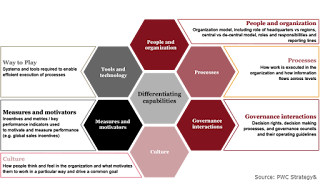The operating model
An "operating model" is how a company organizes and manages its resources to achieve its strategic vision. It is the bridge between strategy and execution. So the manner in which a company creates or updates its operating model to match changes in strategy is a crucial question for transformation programs.
Structure - the company's organization chart, if you will - is primarily about accountabilities. Especially as companies transition to agile, they must learn to balance this accountability with increased autonomy. The new operating model also requires a governance structure and leadership model so leaders know how they will exercise operational control and inspire employees.
Operating models involve everything from choosing the right dashboard, defining the metrics that matter, planning, resource allocation, and budgeting. It also includes defining how you manage assignments and career paths of employees who make a difference.
Operating models must also define ways of working and behaviours that actualize your strategy. Whether it is lower costs or superb service, the entire organization - not just frontline functions -need to get on board. What high-performance behaviours are non-negotiable, and how do you make sure that you are enabling and reinforcing them? What is your approach to risk-taking and experimentation?
And finally, does the operating model support the company's strategic mission with the right combination of people, process, technology and tools? Have you determined the opex/capex priorities to build these differentiated capabilities?
A common mistake that companies make when tackling what are essentially complex and often political questions is that they dive straight into a detailed redesign of their operating model - and lose sight of strategic intent.
Operating model must start with a blueprint based on a few basic principles. First, agree on what really matters to deliver your strategy. Effective principles share three characteristics:
From there, the organization will have the requisite diversity to deal with these events, as well as design and conduct safe-to-fail experiments on a regular basis. The framework is great to develop a consensus amongst the leadership team on the type and quantum of new capabilities needed to operate in an extremely competitive environment.
REFERENCES
1. Is your company actually setup to support your strategy?; Eric Garton' Nov 22, 2017; hbr.org;
2. Operating model; strategyand.pwc.com;
3. Winning operating models that convert strategy to results; Bain Brief By Marcia Blenko, Eric Garton and Ludovica Mottura; December 10, 2014; bain.com
 |
| A sample operating model blueprint Source: PWC Strategy& |
 |
| Operating model serves as a bridge connecting strategy and execution Source: bain.com |
 |
| Ikea anchors its cost leadership position on several differentiated capabilities Source: bain.com |
Operating models involve everything from choosing the right dashboard, defining the metrics that matter, planning, resource allocation, and budgeting. It also includes defining how you manage assignments and career paths of employees who make a difference.
Operating models must also define ways of working and behaviours that actualize your strategy. Whether it is lower costs or superb service, the entire organization - not just frontline functions -need to get on board. What high-performance behaviours are non-negotiable, and how do you make sure that you are enabling and reinforcing them? What is your approach to risk-taking and experimentation?
 |
| Elements of an operating model Source: McKinsey |
And finally, does the operating model support the company's strategic mission with the right combination of people, process, technology and tools? Have you determined the opex/capex priorities to build these differentiated capabilities?
A common mistake that companies make when tackling what are essentially complex and often political questions is that they dive straight into a detailed redesign of their operating model - and lose sight of strategic intent.
Operating model must start with a blueprint based on a few basic principles. First, agree on what really matters to deliver your strategy. Effective principles share three characteristics:
- They are grounded in facts in order to bring objectivity
- They are specific enough to help senior management make the trade-offs
- They are brief, and should ideally fit on a single page
Then identify the capabilities, individuals and teams that matter. Here is where agility and dynamic cross-functional teams with real authority and support really matter. The dynamism gives rise to friction or conflict, which is desirable, as long as it remains constructive. Effective operating models involve designing in creative conflict, as well as the means for efficiently and effectively resolving these conflicts. Working together, the results are often inspired outcomes for customers and other stakeholders.
 |
| Next generation operating model Source: McKinsey |
And very often, redesign of the operating model must start with the redesign of the leadership team. And at every stage, clarity and simplicity, and the use of frameworks such as Cynefin, play an essential role in bringing everyone onto the same page.
Risk events can have many different levels of complexity. A cost focus dumbs down the organization to the "KNOWN" domain or the domain of "best practices". As a result, the organization loses its capability (read agility) to sense and respond to more complex events. What is really needed is to invest and build in enough flexibility to bring the capability centre-of-gravity to the boundary between "knowable" and "complex".From there, the organization will have the requisite diversity to deal with these events, as well as design and conduct safe-to-fail experiments on a regular basis. The framework is great to develop a consensus amongst the leadership team on the type and quantum of new capabilities needed to operate in an extremely competitive environment.
REFERENCES
1. Is your company actually setup to support your strategy?; Eric Garton' Nov 22, 2017; hbr.org;
2. Operating model; strategyand.pwc.com;
3. Winning operating models that convert strategy to results; Bain Brief By Marcia Blenko, Eric Garton and Ludovica Mottura; December 10, 2014; bain.com




Comments
Post a Comment